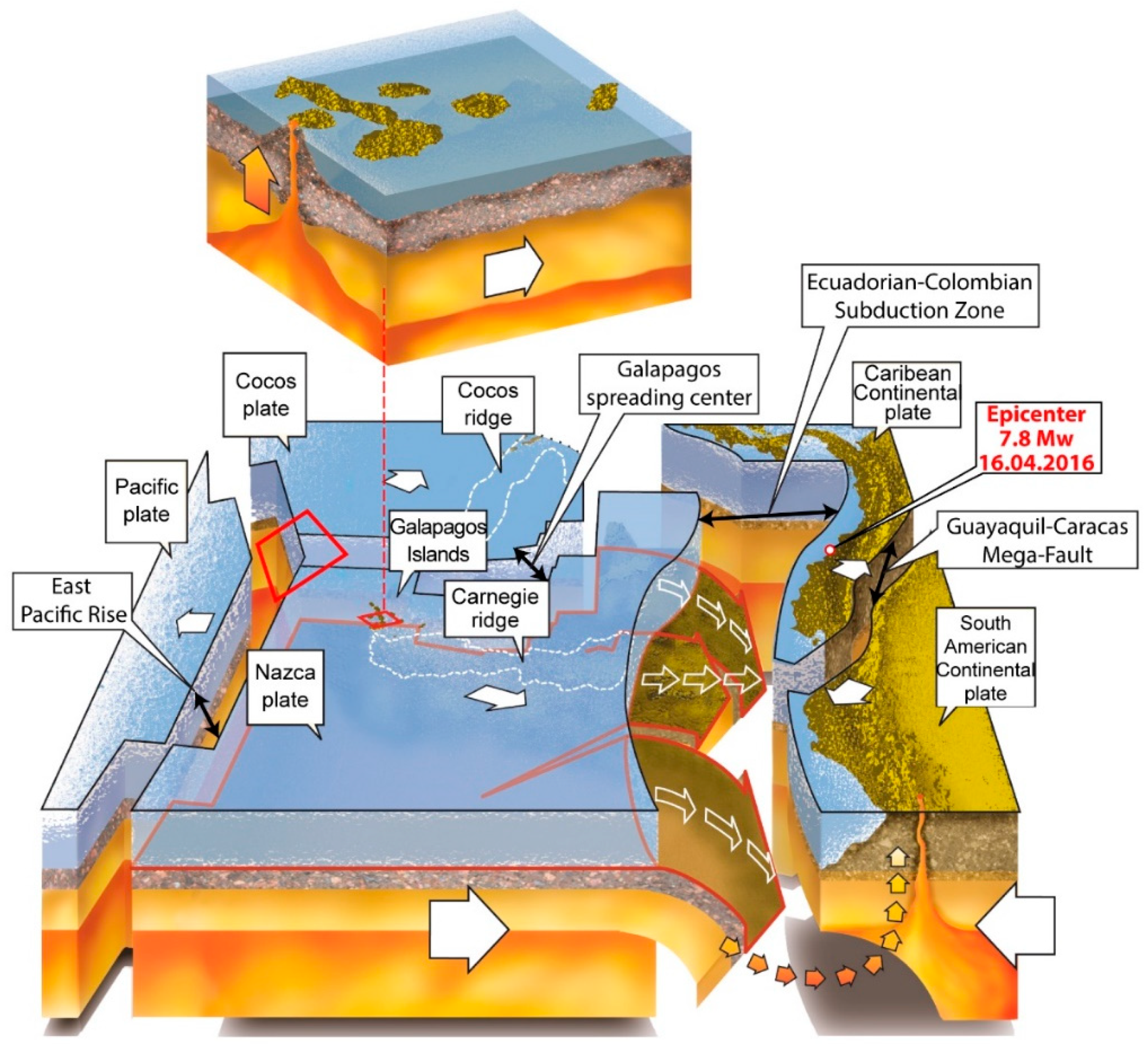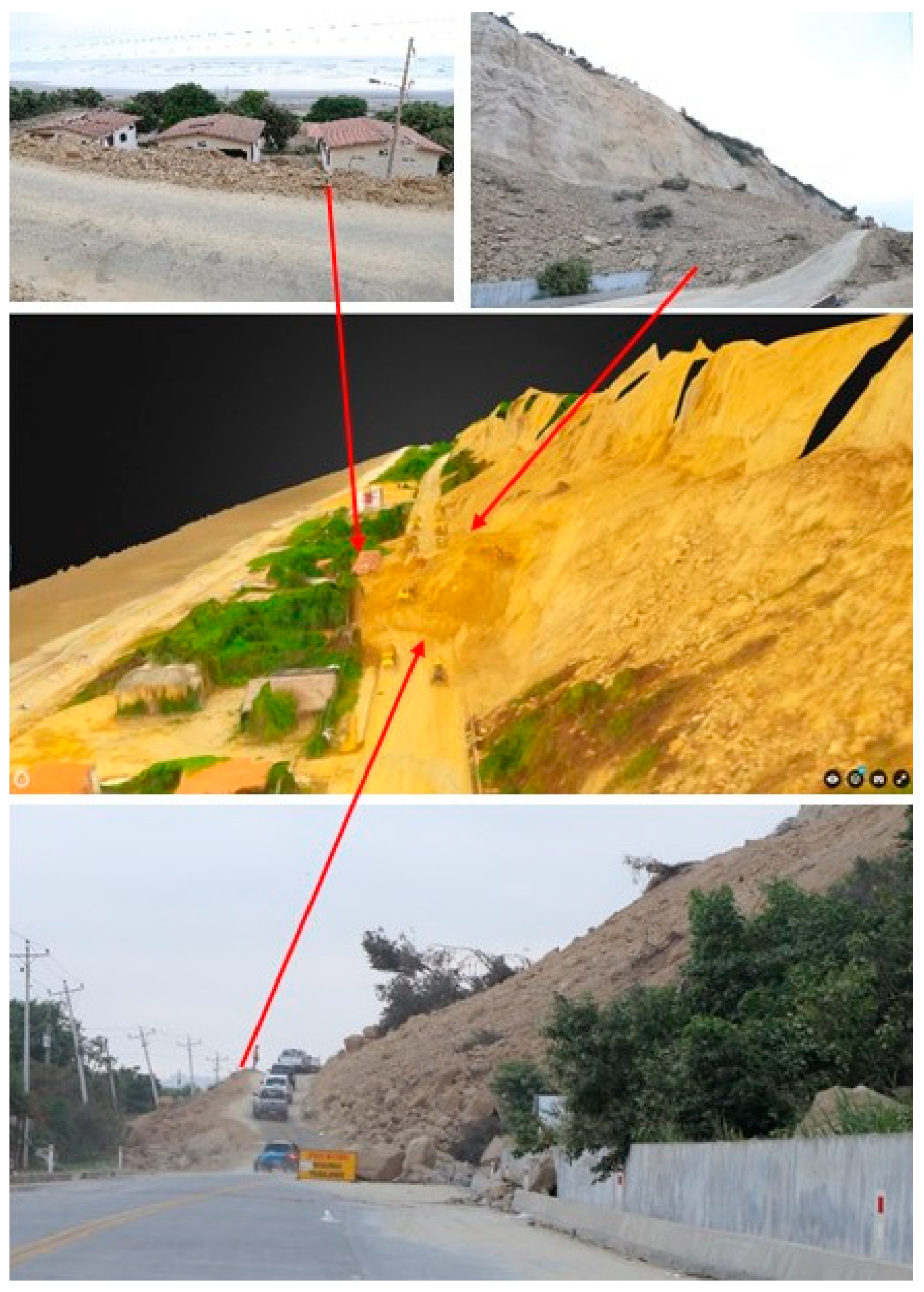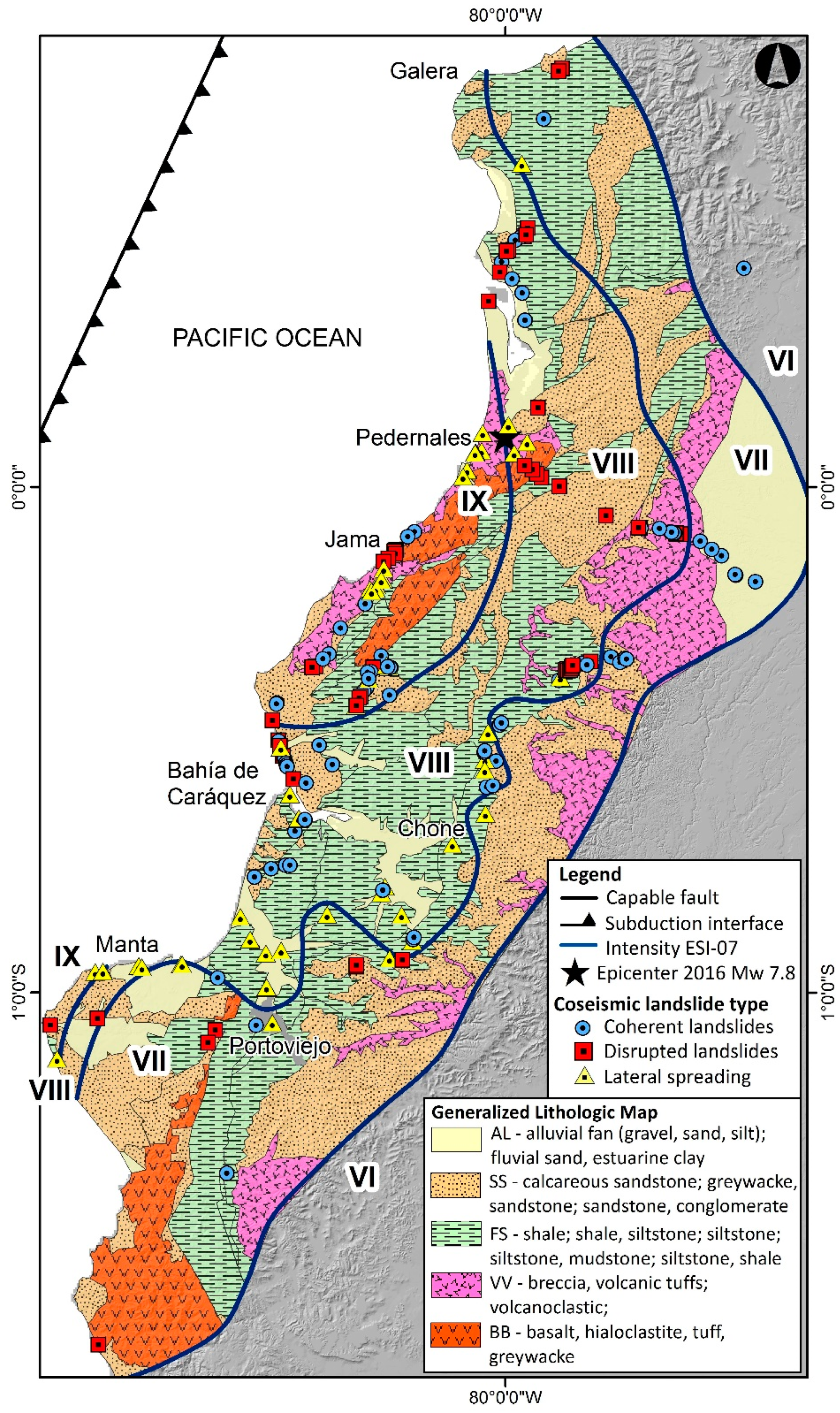Landslides Triggered by the 2016 Mw 7.8 Pedernales, Ecuador Earthquake: Correlations with ESI-07 Intensity, Lithology, Slope and PGA-h
Abstract
:1. Introduction
2. Description of the Study Area
3. Seismotectonic Setting and the 2016 Pedernales Earthquake Sequence
4. Methods and Materials
5. Results and Discussion
6. Conclusions
Supplementary Materials
Author Contributions
Funding
Acknowledgments
Conflicts of Interest
References
- Michetti, A.M.; Esposito, E.; Guerrieri, L.; Porfido, S.; Serva, L.; Tatevossian, R.; Vittori, E.; Audemard, F.; Azuma, T.; Clague, J.; et al. Environmental Seismic Intensity Scale 2007—ESI 2007. In Memorie Descrittive della Carta Geologica d’Italia, 74, 7-54; Servizio Geologico d’Italia—Dipartimento Difesa del Suolo, APAT: Roma, Italy, 2007. Available online: http://www.isprambiente.gov.it/en/publications/technical-periodicals/descriptive-memories-of-the-geological-map-of/intensity-scale-esi-2007?set_language=en (accessed on 15 August 2019).
- Serva, L. History of the Environmental Seismic Intensity Scale ESI-07. Geosciences 2019, 9, 210. [Google Scholar] [CrossRef]
- Keefer, D.K. Landslides caused by earthquakes. Geol. Soc. Am. Bull. 1984, 95, 406–421. [Google Scholar] [CrossRef]
- Harp, E.L.; Jibson, R.W. Landslides triggered by the 1994 Northridge, California, earthquake. Bull. Seismol. Soc. Am. 1996, 86, S319–S332. [Google Scholar]
- Berzhinskii, Y.A.; Ordynskaya, A.P.; Gladkov, A.S.; Lunina, O.V.; Berzhinskaya, L.P.; Radziminovich, N.A.; Radziminovich, Y.B.; Imayev, V.S.; Chipizubov, A.V.; Smekalin, O.P. Application of the ESI-2007 scale for estimating the intensity of the Kultuk earthquake, August 27, 2008 (south Baikal). Seism. Instrum. 2010, 46, 307–324. [Google Scholar] [CrossRef]
- Delgado, J.; Peláez, J.A.; Tomás, R.; García-Tortosa, F.J.; Alfaro, P.; Casado, C.L. Seismically-induced landslides in the Betic Cordillera (S Spain). Soil Dynam. Earthq. Eng. 2011, 31, 1203–1211. [Google Scholar] [CrossRef]
- Serva, L.; Vittori, E.; Comerci, V.; Esposito, E.; Guerrieri, L.; Michetti, A.M.; Mohammadioun, B.; Mohammadioun, G.C.; Porfido, S.; Tatevossian, R.E. Earthquake Hazard and the Environmental Seismic Intensity (ESI) Scale. Pure Appl. Geophys. 2016, 173, 1479–1515. [Google Scholar] [CrossRef]
- Xu, C.; Ma, S.; Tan, Z.; Xie, C.; Toda, S.; Huang, X. Landslides triggered by the 2016 Mj 7.3 Kumamoto, Japan, earthquake. Landslides 2018, 15, 551. [Google Scholar] [CrossRef]
- Huayong, N.; Hua, G.; Yanchao, G.; Blumetti, A.M.; Comerci, V.; Di Manna, P.; Guerrieri, L.; Vittori, E. Comparison of Earthquake Environmental Effects and ESI intensities for recent seismic events in different tectonic settings: Sichuan (SW China) and Central Apennines (Italy). Eng. Geol. 2019, 258, 105149. [Google Scholar] [CrossRef]
- Di Manna, P.; Guerrieri, L.; Piccardi, L.; Vittori, E.; Castaldini, D.; Berlusconi, A.; Bonadeo, L.; Comerci, V.; Ferrario, F.; Gambillara, R.; et al. Ground effects induced by the 2012 seismic sequence in Emilia: Implications for seismic hazard assessment in the Po Plain. Ann. Geophys. 2012, 55, 697–703. [Google Scholar]
- Egred, J. Catalogo de Terremotos del Ecuador 1541–2009; Internal Report; Escuela Politecnica Nacional, Instituto Geofisico: Quito, Ecuador, 2009. [Google Scholar]
- Chunga, K. Shallow Crustal Earthquakes and Seismic Zonation for Ecuador through the Integration of Geological, Seismological and Morphostructural Data. Ph.D. Thesis, University of Insubria, Varese, Italy, 2010. [Google Scholar]
- Chunga, K.; Toulkeridis, T.; Vera-Grunauer, X.; Gutierrez, M.; Cahuana, N.; Alvarez, A. A review of earthquakes and tsunami records and characterization of capable faults on the northwestern coast of Ecuador. J. Sci. Tsunami Hazards 2017, 36, 100–127. [Google Scholar]
- Tibaldi, A.; Ferrari, L.; Pasquarè, G. Landslides triggered by earthquakes and their relations with faults and mountain slope geometry: An example from Ecuador. Geomorphology 1995, 11. [Google Scholar] [CrossRef]
- Beauval, C.; Yepes, H.; Bakun, W.H.; Egred, J.; Alvarado, A.; Singaucho, J.C. Locations and magnitudes of historical earthquakes in the Sierra of Ecuador (1587-1996). Geophys. J. Int. 2010, 181, 1613–1633. [Google Scholar] [CrossRef] [Green Version]
- Beauval, C.; Yepes, H.; Palacios, P.; Segovia, M.; Alvarado, A.; Font, Y.; Aguilar, J.; Troncoso, L.; Vaca, S. An earthquake catalog for seismic hazard assessment in Ecuador. Bull. Seism. Soc. Am. 2013, 103, 773–786. [Google Scholar] [CrossRef]
- Crespo, E.; O’Rourke, T.D.; Nyman, K.J. Effects on lifelines. In The March 5, 1987, Ecuador Earthquakes: Mass Wasting & Socioeconomic Effects; National Research Council: Washington, DC, USA, 1991; Chapter 6. [Google Scholar]
- Gómez-Capera, A.A.; Leschiutta, I. Determining the parameters of earthquake sources in South America from macroseismic intensity data (CERESIS database). Earth Sci. Res. J. 2004, 8, 10. [Google Scholar]
- Giesecke, A.; Capera, A.G.; Leschiutta, I.; Migliorini, E.; Valverde, L.R. The CERESIS earthquake catalogue and database of the Andean Region: Background, characteristics and examples of use. Ann. Geophys. 2004, 47. [Google Scholar] [CrossRef]
- IGEPN. Instituto Geofísico Escuela Politécnica Nacional. Quito. Available online: http://www.igepn.edu.ec/solicitud-de-datos (accessed on 10 May 2019).
- Toulkeridis, T.; Chunga, K.; Rentería, W.; Rodriguez, F.; Mato, F.; Nikolaou, S.; Antonaki, N.; Diaz-Fanas, G.; Besenzon, D. Mw7.8 Muisne, Ecuador 4/16/16 earthquake observations: Geophysical clustering, intensity mapping, tsunami. In Proceedings of the 16th World Conference on Earthquake Engineering, 16WCEE 2017, Santiago, Chile, 9–13 January 2017. [Google Scholar]
- Chunga, K.; Livio, F.; Mulas, M.; Ochoa-Cornejo, F.; Besenzon, D.; Ferrario, M.F.; Michetti, A.M. Earthquake ground effects and intensity of the 16 April 2016, Mw 7.8 Pedernales Earthquake (Ecuador): Implications for the source characterization of large subduction earthquakes. Bull. Seismol. Soc. Am. 2018, 108, 3384–3397. [Google Scholar] [CrossRef]
- NEC-11. 2015. Norma Ecuatoriana de la Construcción. Registro Oficial No. 413 del 10 de enero de 2015. Available online: http://www.normaconstruccion.ec/ (accessed on 11 April 2019).
- Nocquet, J.M.; Jarrin, P.; Vallée, M.; Mothes, P.A.; Grandin, R.; Rolandone, F.; Delouis, B.; Yepes, H.; Font, Y.; Fuentes, D.; et al. Supercycle at the Ecuadorian subduction zone revealed after the 2016 Pedernales earthquake. Nat. Geosci. 2016, 10, 145–149. [Google Scholar] [CrossRef]
- Toulkeridis, T.; Porras, T.; Tierra, A.; Toulkeridis-Estrella, K.; Cisneros, D.; Luna, M.; Carrión, J.L.; Herrera, M.; Murillo, A.; Perez, J.C.; et al. Two independent real-time precursors of the 7.8 Mw earthquake in Ecuador based on radioactive and geodetic processes—Powerful tools for an early warning system. J. Geodyn. 2019, 126, 12–22. [Google Scholar] [CrossRef]
- Pourrut, P. Los Climas del Ecuador: Fundamentos Explicativos. In Los climas del Ecuador; CEDIG: Quito, Ecuador; Institut de recherche pour le développement: Marseille, France, 1983; pp. 7–41. [Google Scholar]
- UNESCO. Atlas Pluviométrico del Ecuador; UNESCO: Quito, Ecuador, 2010. [Google Scholar]
- Pourrut, P.; Róvere, O.; Romo, I.; Villacrés, H. Clima del Ecuador. In El Agua en el Ecuador: Clima, Precipitaciones, Escorrentía; Institut de recherche pour le développement: Marseille, France, 1995; pp. 13–26. [Google Scholar]
- Kottek, M.; Grieser, J.; Beck, C.; Rudolf, B.; Rubel, F. World map of the Köppen-Geiger climate classification updated. Meteorol. Z. 2006, 15, 259–263. [Google Scholar] [CrossRef]
- Hey, R. Tectonic evolution of the Cocos-Nazca spreading center. Geol. Soc. Am. Bull. 1977, 88, i–vi. [Google Scholar] [CrossRef]
- Lonsdale, P. Ecuadorian subduction system. AAPG Bull. 1978, 62, 2454–2477. [Google Scholar]
- Pennington, W.D. Subduction of the eastern Panama Basin and seismotectonics of northwestern South America. J. Geophys. Res. B Solid Earth Planets 1981, 86, 10753–10770. [Google Scholar] [CrossRef]
- Eguez, A.; Alvarado, A.; Yepes, H.; Machette, M.N.; Costa, C.; Dart, R.L.; Bradley, L.A. Database and Map of Quaternary Faults and Folds of Ecuador and Its Offshore Regions; Open-File Report 03-289; US Geological Survey: Reston, VA, USA, 2003. Available online: https://pubs.usgs.gov/of/2003/ofr-03-289/ (accessed on 5 March 2019).
- Veloza, G.; Styron, R.M.; Taylor Mora, A. Open-source archive of active faults for northwest South America. GSA Today 2012, 22, 4–10. [Google Scholar] [CrossRef]
- Sallarès, V.; Charvis, P. Crustal thickness constraints on the geodynamic evolution of the Galapagos Volcanic Province. Earth Planet. Sci. Lett. 2003, 214, 545–559. [Google Scholar] [CrossRef] [Green Version]
- Gutscher, M.A.; Malavieille, J.; Lallemand, S.; Collot, J.Y. Tectonic segmentation of the North Andean margin: Impact of the Carnegie Ridge collision. Earth Planet. Sci. Lett. 1999, 168, 255–270. [Google Scholar] [CrossRef]
- Michaud, F.; Witt, C.; Royer, J.Y. Influence of the subduction of the Carnegie volcanic ridge on Ecuadorian geology: Reality and fiction. In Backbone of the Americas: Shallow Subduction, Plateau Uplift, and Ridge and Terrane Collision; Mahlburg Kay, S., Ramos, V., Dickinson, W., Eds.; The Geological Society of America: Boulder, CO, USA, 2009; pp. 217–228. [Google Scholar]
- Blanco-Chao, R.; Pedoja, K.; Witt, C.; Martinod, J.; Husson, L.; Regard, V.; Audin, L.; Nexer, M.; Delcaillau, B.; Saillard, M.; et al. The rock coast of South and Central America. In Memoirs; Geological Society: London, UK, 2014; Volume 40, pp. 155–191. [Google Scholar] [CrossRef]
- Pedoja, K.; Dumont, J.F.; Lamothe, M.; Ortlieb, L.; Collot, J.Y.; Ghaleb, B.; Auclair, M.; Alvarez, V.; Labrousse, B. Plio-Quaternary uplift of the Manta Peninsula and La Plata Island and the subduction of the Carnegie Ridge, central coast of Ecuador. J. South Am. Earth Sci. 2006, 22, 1–21. [Google Scholar] [CrossRef]
- White, S.M.; Trenkamp, R.; Kellogg, J.N. Recent crustal deformation and the earthquake cycle along the Ecuador–Colombia subduction zone. Earth Planet. Sci. Lett. 2003, 216, 231–242. [Google Scholar] [CrossRef]
- Graindorge, D.; Calahorrano, A.; Charvis, P.; Collot, J.Y.; Bethoux, N. Deep structures of the Ecuador convergent margin and the Carnegie Ridge, possible consequence on great earthquakes recurrence interval. Geophys. Res. Lett. 2004, 31, L04603. [Google Scholar] [CrossRef]
- Chlieh, M.; Mothes, P.A.; Nocquet, J.M.; Jarrin, P.; Charvis, P.; Cisneros, D.; Font, Y.; Collot, J.Y.; Villegas-Lanza, J.C.; Rolandone, F.; et al. Distribution of discrete seismic asperities and aseismic slip along the Ecuadorian megathrust. Earth Planet. Sci. Lett. 2014, 400, 292–301. [Google Scholar] [CrossRef]
- Nocquet, J.M.; Villegas-Lanza, J.C.; Chlieh, M.; Mothes, P.A.; Rolandone, F.; Jarrin, P.; Cisneros, D.; Alvarado, A.; Audin, L.; Bondoux, F.; et al. Motion of continental slivers and creeping subduction in the northern Andes. Nat. Geosci. 2014, 7, 287–291. [Google Scholar] [CrossRef]
- Yepes, H.; Audin, L.; Alvarado, A.; Beauval, C.; Aguilar, J.Y.; Font Cotton, F. A new view for the geodynamics of Ecuador: Implication in seismogenic source definition and seismic hazard assessment. Tectonics 2016, 35, 1249–1279. [Google Scholar] [CrossRef] [Green Version]
- Alvarado, A.; Audin, L.; Nocquet, J.M.; Jaillard, E.; Mothes, P.; Jarrín, P.; Segovia, M.; Rolandone, F.; Cisneros, D. Partitioning of oblique convergence in the Northern Andes subduction zone: Migration history and the present-day boundary of the North Andean Sliver in Ecuador. Tectonics 2016, 35, 1048–1065. [Google Scholar] [CrossRef] [Green Version]
- Marcaillou, B.; Collot, J.Y.; Ribodetti, A.; d’Acremont, E.; Mahamat, A.A.; Alvarado, A. Seamount subduction at the North-Ecuadorian convergent margin: Effects on structures, inter-seismic coupling and seismogenesis. Earth Planet. Sci. Lett. 2016, 433, 146–158. [Google Scholar] [CrossRef]
- Collot, J.Y.; Sanclemente, E.; Nocquet, J.M.; Leprêtre, A.; Ribodetti, A.; Jarrin, P.; Chlieh, M.; Graindorges, D.; Charvis, P. Subducted oceanic relief locks the shallow megathrust in central Ecuador. J. Geophys. Res. B Solid Earth Planets 2017, 122, 3286–3305. [Google Scholar] [CrossRef]
- Swenson, J.L.; Beck, S.L. Historical 1942 Ecuador and 1942 Peru subduction earthquakes and earthquake cycles along Colombia-Ecuador and Peru subduction segments. Pure Appl. Geophys. 1996, 146, 67–101. [Google Scholar] [CrossRef]
- Ye, L.; Kanamori, H.; Avouac, J.P.; Li, L.; Cheung, K.F.; Lay, T. The 16 April 2016, Mw 7.8 (Ms 7.5) Ecuador earthquake: A quasi-repeat of the 1942 M S 7.5 earthquake and partial re-rupture of the 1906 Ms 8.6 Colombia–Ecuador earthquake. Earth Planet. Sci. Lett. 2016, 454, 248–258. [Google Scholar] [CrossRef]
- Gómez-Capera, A.A.; Stucchi, M.; Arcila, M.; Bufaliza, M.; Choy, J.; Minaya, E.; Leyton, L.; Pirchiner, M.; Rendón, H.; Rodriguez, L.; et al. Updated Earthquake Catalogue For South America: Time Window Pre-1964. In Proceedings of the 16th World Conference on Earthquake, 16WCEE 2017, Santiago, Chile, 9–13 January 2017. [Google Scholar]
- Beauval, C.; Marinière, J.; Yepes, H.; Audin, L.; Nocquet, J.M.; Alvarado, A.; Baize, S.; Aguilar, J.; Singaucho, J.C.; Jomard, H. A New Seismic Hazard Model for Ecuador. Bull. Seismol. Soc. Am. 2018, 108, 1443–1464. [Google Scholar] [CrossRef]
- García-Bustos, S.; Landín, J.; Moreno, R.; Chong, A.S.E.; Mulas, M.; Mite, M.; Cárdenas, N. Statistical analysis of the largest possible earthquake magnitudes on the Ecuadorian coast for selected return periods. Georisk Assess. Manag. Risk Eng. Syst. Geohazards 2018. [Google Scholar] [CrossRef]
- He, P.; Hetland, E.A.; Wang, Q.; Ding, K.; Wen, Y.; Zou, R. Coseismic Slip in the 2016 Mw 7.8 Ecuador Earthquake Imaged from Sentinel-1A Radar Interferometry. Seismol. Res. Lett. 2017, 88, 277–286. [Google Scholar] [CrossRef]
- Hancox, G.T.; Perrin, N.D.; Dellow, G.D. Recent studies of historical earthquake-induced landsliding, ground damage, and MM intensity in New Zealand. Bull. New Zealand Soc. Earthq. Eng. 2002, 35, 59–95. [Google Scholar] [Green Version]
- Reyes, P.; Michaud, F. Mapa Geológico de la Margen Costera Ecuatoriana (1: 500.000); Quito, Ecuador; Institut de recherche pour le développement: Marseille, France, 2012. [Google Scholar]
- Kelson, K.; Witter, R.C.; Tassara, A.; Ryder, I.; Ledezma, C.; Montalva, G.; Frost, D.; Sitar, N.R.; Moss Johnson, L. Coseismic tectonic surface deformation during the 2010 Maule, Chile, Mw 8.8 earthquake. Earthq. Spectra 2012, 28, S39–S54. [Google Scholar] [CrossRef]
- Wartman, J.; Dunham, L.; Tiwari, B.; Pradel, D. Landslides in Eastern Honshu induced by the 2011 off the Pacific Coast of Tohoku earthquake. Bull. Seismol. Soc. Am. 2013, 103, 1503–1521. [Google Scholar] [CrossRef]
- Serey, A.; Piñero-Feliciangeli, L.; Sepúlveda, S.A.; Iveda, F.; Poblete, D.; Petley, I.; Murphy, W. Landslides induced by the 2010 Chile megathrust earthquake: A comprehensive inventory and correlations with geological and seismic factors. Landslides 2019, 16, 1153. [Google Scholar] [CrossRef]
- Sieberg, A. Geologie der Erdbeden. In Handbuch der Geophysik; Harold, J., Ed.; Nature: London, UK, 1930; Volume 2, pp. 550–555. [Google Scholar]
- Wood, H.O.; Neumann, F. Modified Mercalli intensity scale of 1931. Bull. Seismol. Soc. Am. 1931, 21, 277–283. [Google Scholar]
- Richter, C.F. Elementary Seismology; Freeman: San Francisco, CA, USA, 1958. [Google Scholar]
- Medvedev, S.; Sponheuer, W.; Karník, V. Neue seismische Skala Intensity Scale of Earthquakes, 7. Tagung der Europäischen Seismologischen Kommission vom 24.9. bis 30.9.1962; Institut für Bodendynamik und Erdbebenforschung in Jena: Jena, Germany; Deutsche Akademie der Wissenschaften zu Berlin: Berlin, Germany, 1964. [Google Scholar]











© 2019 by the authors. Licensee MDPI, Basel, Switzerland. This article is an open access article distributed under the terms and conditions of the Creative Commons Attribution (CC BY) license (http://creativecommons.org/licenses/by/4.0/).
Share and Cite
Chunga, K.; Livio, F.A.; Martillo, C.; Lara-Saavedra, H.; Ferrario, M.F.; Zevallos, I.; Michetti, A.M. Landslides Triggered by the 2016 Mw 7.8 Pedernales, Ecuador Earthquake: Correlations with ESI-07 Intensity, Lithology, Slope and PGA-h. Geosciences 2019, 9, 371. https://doi.org/10.3390/geosciences9090371
Chunga K, Livio FA, Martillo C, Lara-Saavedra H, Ferrario MF, Zevallos I, Michetti AM. Landslides Triggered by the 2016 Mw 7.8 Pedernales, Ecuador Earthquake: Correlations with ESI-07 Intensity, Lithology, Slope and PGA-h. Geosciences. 2019; 9(9):371. https://doi.org/10.3390/geosciences9090371
Chicago/Turabian StyleChunga, Kervin, Franz A. Livio, Carlos Martillo, Hernán Lara-Saavedra, Maria Francesca Ferrario, Ivan Zevallos, and Alessandro Maria Michetti. 2019. "Landslides Triggered by the 2016 Mw 7.8 Pedernales, Ecuador Earthquake: Correlations with ESI-07 Intensity, Lithology, Slope and PGA-h" Geosciences 9, no. 9: 371. https://doi.org/10.3390/geosciences9090371




